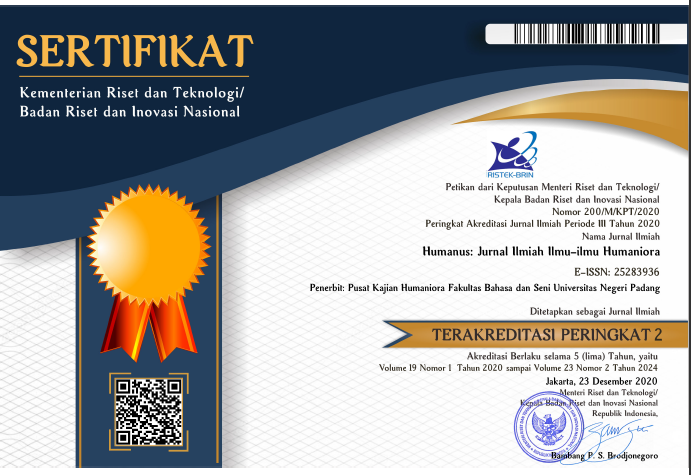The Representation of Baba-Nyonya Cuisine in the Context of Halal Tourism Industry in Malacca, Malaysia
 ), Syafiq Akmal Sazali(2), Muhammad Nasirin Abu Bakar(3),
), Syafiq Akmal Sazali(2), Muhammad Nasirin Abu Bakar(3), (1) Universitas Gadjah Mada
(2) Kolej Universiti Islam Melaka
(3) Kolej Universiti Islam Melaka
 Corresponding Author
Corresponding Author
Copyright (c) 2020 Humanus
DOI : https://doi.org/10.24036/humanus.v19i1.107681
Full Text:
 Language : en
Language : en
Abstract
Keywords
References
Ambali, A. R., & Bakar, A. N. (2014). People’s Awareness on Halal Foods and Products: Potential Issues for Policy-makers. Procedia - Social and Behavioral Sciences, 121, 3–25. doi:10.1016/j.sbspro.2014.01.1104
Abdul Majid, M. A., Zainal Abidin, I. H., Mohd Abd Majid, H. A., & Tamby Chik, C. (2015). Issues of Halal Food Implementation in Malaysia. Journal of Applied Environmental and Biological Sciences, 5, 50–56. https://doi.org/10.1016/S0013-4686(00)00333-9
Battour, M., Battor, M., & Bhatti, M. A., (2014). Islamic attributes of destinations: construct development and validation, and their impact on tourist satisfaction. International Journal of Tourism Research, 16(6), 556-564. https://doi.org/10.1002/jtr.1947
Battour, M. M., Battor, M. M., & Ismail, M. (2012). The mediating role of tourist satisfaction: A study of Muslim tourists in Malaysia. Journal of Travel and Tourism Marketing, 29(3), 279–297. doi:10.1080/10548408.2012.666174
Bohari, A. M., Wei Hin, C., & Fuad, N. (2013). The competitiveness of halal food industry in Malaysia : A SWOT - ICT analysis. Malaysia Journal of Society and Space, 9(1), 1–9. https://doi.org/10.5539/ass.v5n7P44
Bon, M., & Hussain, M. (2010). Halal food and tourism: Prospects and challenges. In N. Scott & J. Jafari (Eds.), Tourism in the Muslim World: Bridging Tourism Theory and Practice Vol. 2 (pp. 47-59). Bingley: Emerald Group Publishing Limited. doi: 10.1108/52042-1443(2010)0000002007.
Crescent Rating. (2014, February 18). Top Halal Friendly Holiday Destinations – 2014. https://www.crescentrating.com/rating-accreditations/rankingdetail.html?id=3602
Fam, S., Dora, M. T., Othman, N. A., Azmi, F. R., Musa, H., Mohamed Azim, A. M., Norman, H., & Abdul Shuib, M. F. I. (2017). Why Tourists Visit Melaka?. Proceedings of 2017 China Marketing International Conference (CMIC 2017), Marketing Strategy in the Sharing Economy: Localization and Globalization, China, 785-807.
Gin, O. O. I. K. (2017). Eclectic Sociocultural Traditions of the Baba Nyonya of George Town, Penang, Malaysia. Suvannabhumi: Multi-disciplinary Journal of Southeast Asian Studies, 9(2), 51–89.
Hanim Yusuf, A., Abdul Shukor, S., & Salwa Ahmad Bustamam, U. (2016). Halal Certification vs Business Growth of Food Industry in Malaysia. Journal of Economics, Business and Management, 4(3), 247–251. doi:10.7763/joebm.2016.v4.399
Hashim, N. H., Murphy, J., & Hashim, N. M. (2007). Islam and online imagery on malaysian tourist destination websites. Journal of Computer-Mediated Communication, 12(3), 1082–1102. doi:10.1111/j.1083-6101.2007.00364.x
Hassan, M. W., & Hall, C. M. (2003). The demand for halal food among Muslim travellers in New Zealand. In C. M. Hall, Sharples, L., Mitchell, R., Macionis N. and Cambourne, B. (Eds.), Food Tourism Around the World: Development, management and markets (pp. 81-101). Oxford: Butterworth Heinemann. doi:10.1016/B978-0-7506-5503-3.50005-1
Ibrahim, S., & Othman, M. (2014). Developing and Validating Halal Service Quality Instrument for Malaysian Food Service Establishments: A Conceptual Paper. Procedia - Social and Behavioral Sciences, 130, 400–408. doi:10.1016/j.sbspro.2014.04.047
JAKIM. (2014). Manual Procedure for Malaysia Halal Certification (Third Revision). doi:10.1017/CBO9781107415324.004
Kivela, J., & Crotts, J. C. (2006). Tourism and Gastronomy: Gastronomy’s Influence on How Tourists Experience a Destination. Journal of Hospitality and Tourism Research, 30(3), 354–377. doi:10.1177/1096348006286797
Lee, S. (2008). The Peranakan Baba Nyonya culture:Resurgence or disappearance?. SARI : Jurnal Alam Dan Tamadun Melayu, 26, 161–170.
Mak, A. H. N., Lumbers, M., Eves, A., & Chang, R. C. Y. (2012). Factors influencing tourist food consumption. International Journal of Hospitality Management, 31(3), 928–936. doi:10.1016/j.ijhm.2011.10.012
Marzuki, S. Z. S., Hall, C. M., & Ballantine, P. W. (2012). Restaurant Manager and Halal Certification in Malaysia. Journal of Foodservice Business Research, 15(2), 195–214. https://doi.org/10.1080/15378020.2012.677654
Ng, C. Y., & Ab. Karim, S. (2016). Historical and contemporary perspectives of the Nyonya food culture in Malaysia. Journal of Ethnic Foods, 3(2), 93–106. https://doi.org/10.1016/j.jef.2016.05.004
Noordin, N., Md Noor, N. L., Hashim, M., & Samicho, Z. (2009). Value chain of Halal certification system: A case of the Malaysia Halal Industry. Proceedings of the European and Mediterranean Conference on Information Systems, EMCIS 2009, (pp. 1-14). http://www.halalrc.org/images/Research%20Material/Literature/Case%20study-VALUE%20CHAIN%20OF%20HALAL%20CERTIFICATION%20SYSTEM.pdf
Oh, Y., Razak, N. F. A. H. A., Wee, D. H. T., Ching, E. L., & Rahman, Z. (2019). The development of Nyonya cuisine in the Malay Archipelago: Penang and Malacca Nyonya cuisine. Journal of Ethnic Foods, 6(1), 1–10. doi:10.1186/s42779-019-0010-x
Putit, L., Muda, M., Mahmood, A. N., Taufek, N. Z. A., & Wahib, N. (2016). Linking ’Halal’ Friendly Hotel Attributes and Customer Satisfaction: The Islamic Tourism Sector. Journal of Emerging Economies & Islamic Research, 4, 43–53. http://www.jeeir.com/v2/index.php/31-current/2016/vol-4-no-4-2016/141-linking-halal-friendly-hotel-attributes-customer-satisfaction
Saaidin, M., Hamid, N. R. A., & Nurbayah, S. (2018). Muslim Consumers’ Perceptions of Service Quality for Halal Food Service Industry. International Journal of Academic Research in Business and Social Sciences, 8(9), 1965–1973. doi:10.6007/ijarbss/v8-i9/4875
Shafaei, F., & Mohamed, B. (2015). Malaysia’s branding as an Islamic tourism hub: An assessment. Geografia - Malaysian Journal of Society and Space, 11(1), 97–106. http://ejournals.ukm.my/gmjss/article/view/18433
Shamsudin, M. N., & Selamat, J. (2005, May 11-13). Changing retail food sector in Malaysia. Proceeding PECC Pacific Food System Outlook Annual Meeting. https://docuri.com/download/changing-retail-food-sector-in-malaysia_59c1cf5ef581710b2863d65f_pdf
Teh, L., & Cabanban, A. S. (2007). Planning for sustainable tourism in southern Pulau Banggi: An assessment of biophysical conditions and their implications for future tourism development. Journal of Environmental Management, 85(4), 999–1008. doi:10.1016/j.jenvman.2006.11.005
Tumin, A., Salehuddin, M., Zahari, M., Ishak, N., & Abdullah, K. M. (2017). The influence of Baba Nyonya acculturation on the Malacca food identity. Journal of Tourism, Hospitality & Culinary Arts, 9(2), 467–480. http://ir.uitm.edu.my/id/eprint/19472
Zakaria, Z. (2008). Tapping Into the World Halal Market: Some Discussions on Malaysian Laws and Standards. Jurnal Syariah, 16, 603–616. https://ejournal.um.edu.my/index.php/JS/article/view/22760
 Article Metrics
Article Metrics
 Abstract Views : 940 times
Abstract Views : 940 times
 PDF Downloaded : 288 times
PDF Downloaded : 288 times
Refbacks
- There are currently no refbacks.
Copyright (c) 2020 Humanus

This work is licensed under a Creative Commons Attribution-NonCommercial 4.0 International License.









